2016 Hyundai Elantra child seat
[x] Cancel search: child seatPage 48 of 498
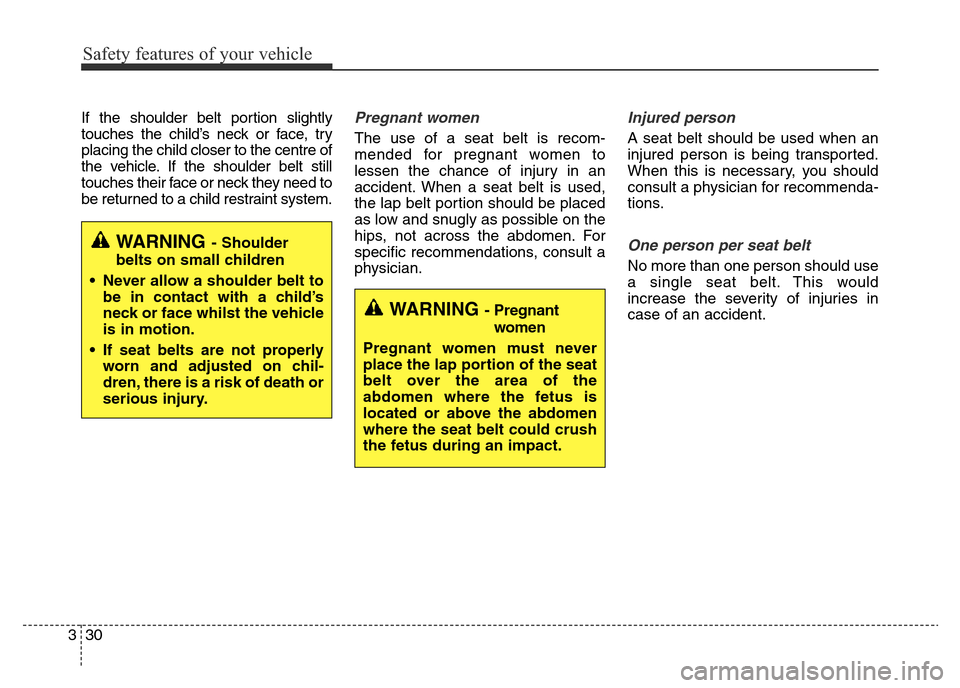
Safety features of your vehicle
30 3
If the shoulder belt portion slightly
touches the child’s neck or face, try
placing the child closer to the centre of
the vehicle. If the shoulder belt still
touches their face or neck they need to
be returned to a child restraint system.Pregnant women
The use of a seat belt is recom-
mended for pregnant women to
lessen the chance of injury in an
accident. When a seat belt is used,
the lap belt portion should be placed
as low and snugly as possible on the
hips, not across the abdomen. For
specific recommendations, consult a
physician.
Injured person
A seat belt should be used when an
injured person is being transported.
When this is necessary, you should
consult a physician for recommenda-
tions.
One person per seat belt
No more than one person should use
a single seat belt. This would
increase the severity of injuries in
case of an accident.
WARNING- Shoulder
belts on small children
• Never allow a shoulder belt to
be in contact with a child’s
neck or face whilst the vehicle
is in motion.
• If seat belts are not properly
worn and adjusted on chil-
dren, there is a risk of death or
serious injury.
WARNING - Pregnant
women
Pregnant women must never
place the lap portion of the seat
belt over the area of the
abdomen where the fetus is
located or above the abdomen
where the seat belt could crush
the fetus during an impact.
Page 51 of 498
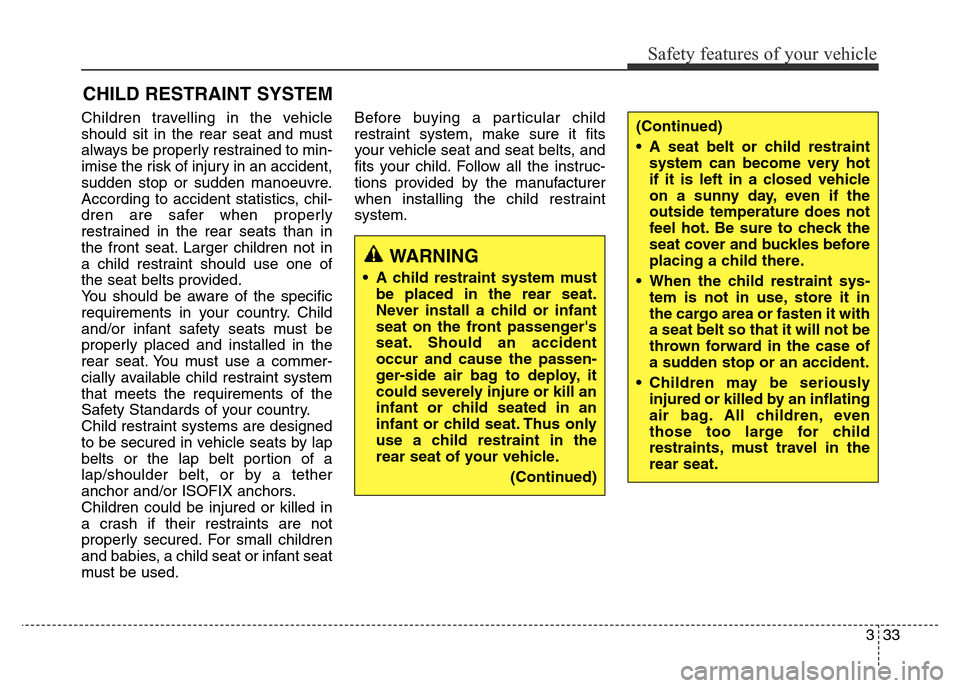
333
Safety features of your vehicle
Children travelling in the vehicle
should sit in the rear seat and must
always be properly restrained to min-
imise the risk of injury in an accident,
sudden stop or sudden manoeuvre.
According to accident statistics, chil-
dren are safer when properly
restrained in the rear seats than in
the front seat. Larger children not in
a child restraint should use one of
the seat belts provided.
You should be aware of the specific
requirements in your country. Child
and/or infant safety seats must be
properly placed and installed in the
rear seat. You must use a commer-
cially available child restraint system
that meets the requirements of the
Safety Standards of your country.
Child restraint systems are designed
to be secured in vehicle seats by lap
belts or the lap belt portion of a
lap/shoulder belt, or by a tether
anchor and/or ISOFIX anchors.
Children could be injured or killed in
a crash if their restraints are not
properly secured. For small children
and babies, a child seat or infant seat
must be used.Before buying a particular child
restraint system, make sure it fits
your vehicle seat and seat belts, and
fits your child. Follow all the instruc-
tions provided by the manufacturer
when installing the child restraint
system.
CHILD RESTRAINT SYSTEM
WARNING
• A child restraint system must
be placed in the rear seat.
Never install a child or infant
seat on the front passenger's
seat. Should an accident
occur and cause the passen-
ger-side air bag to deploy, it
could severely injure or kill an
infant or child seated in an
infant or child seat. Thus only
use a child restraint in the
rear seat of your vehicle.
(Continued)
(Continued)
• A seat belt or child restraint
system can become very hot
if it is left in a closed vehicle
on a sunny day, even if the
outside temperature does not
feel hot. Be sure to check the
seat cover and buckles before
placing a child there.
• When the child restraint sys-
tem is not in use, store it in
the cargo area or fasten it with
a seat belt so that it will not be
thrown forward in the case of
a sudden stop or an accident.
• Children may be seriously
injured or killed by an inflating
air bag. All children, even
those too large for child
restraints, must travel in the
rear seat.
Page 52 of 498
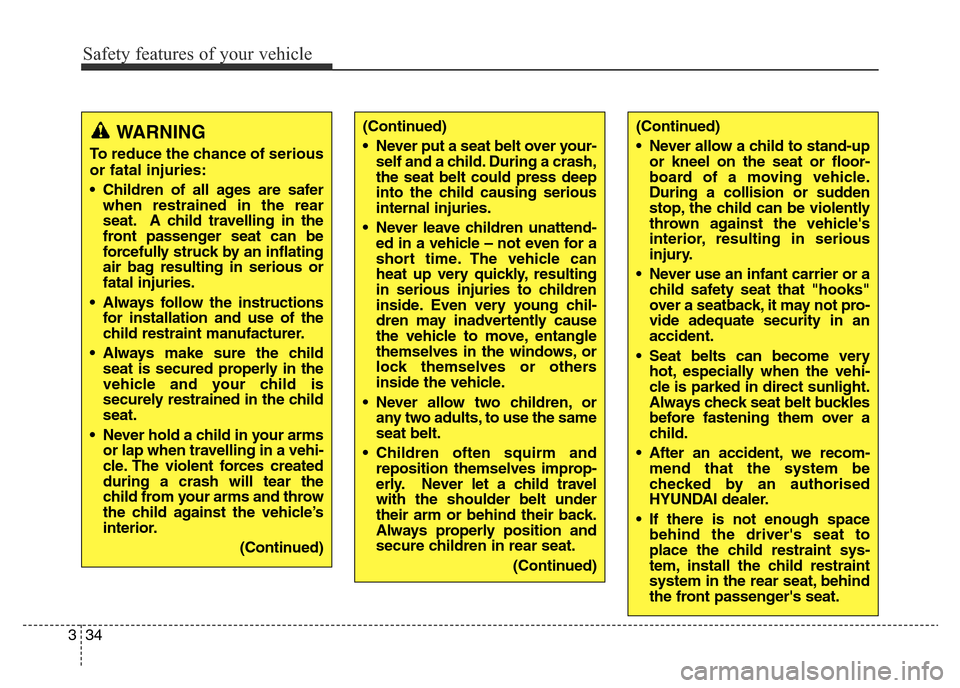
Safety features of your vehicle
34 3
(Continued)
• Never put a seat belt over your-
self and a child. During a crash,
the seat belt could press deep
into the child causing serious
internal injuries.
• Never leave children unattend-
ed in a vehicle – not even for a
short time. The vehicle can
heat up very quickly, resulting
in serious injuries to children
inside. Even very young chil-
dren may inadvertently cause
the vehicle to move, entangle
themselves in the windows, or
lock themselves or others
inside the vehicle.
• Never allow two children, or
any two adults, to use the same
seat belt.
• Children often squirm and
reposition themselves improp-
erly. Never let a child travel
with the shoulder belt under
their arm or behind their back.
Always properly position and
secure children in rear seat.
(Continued)(Continued)
• Never allow a child to stand-up
or kneel on the seat or floor-
board of a moving vehicle.
During a collision or sudden
stop, the child can be violently
thrown against the vehicle's
interior, resulting in serious
injury.
• Never use an infant carrier or a
child safety seat that "hooks"
over a seatback, it may not pro-
vide adequate security in an
accident.
• Seat belts can become very
hot, especially when the vehi-
cle is parked in direct sunlight.
Always check seat belt buckles
before fastening them over a
child.
• After an accident, we recom-
mend that the system be
checked by an authorised
HYUNDAI dealer.
• If there is not enough space
behind the driver's seat to
place the child restraint sys-
tem, install the child restraint
system in the rear seat, behind
the front passenger's seat.WARNING
To reduce the chance of serious
or fatal injuries:
• Children of all ages are safer
when restrained in the rear
seat. A child travelling in the
front passenger seat can be
forcefully struck by an inflating
air bag resulting in serious or
fatal injuries.
• Always follow the instructions
for installation and use of the
child restraint manufacturer.
• Always make sure the child
seat is secured properly in the
vehicle and your child is
securely restrained in the child
seat.
• Never hold a child in your arms
or lap when travelling in a vehi-
cle. The violent forces created
during a crash will tear the
child from your arms and throw
the child against the vehicle’s
interior.
(Continued)
Page 53 of 498
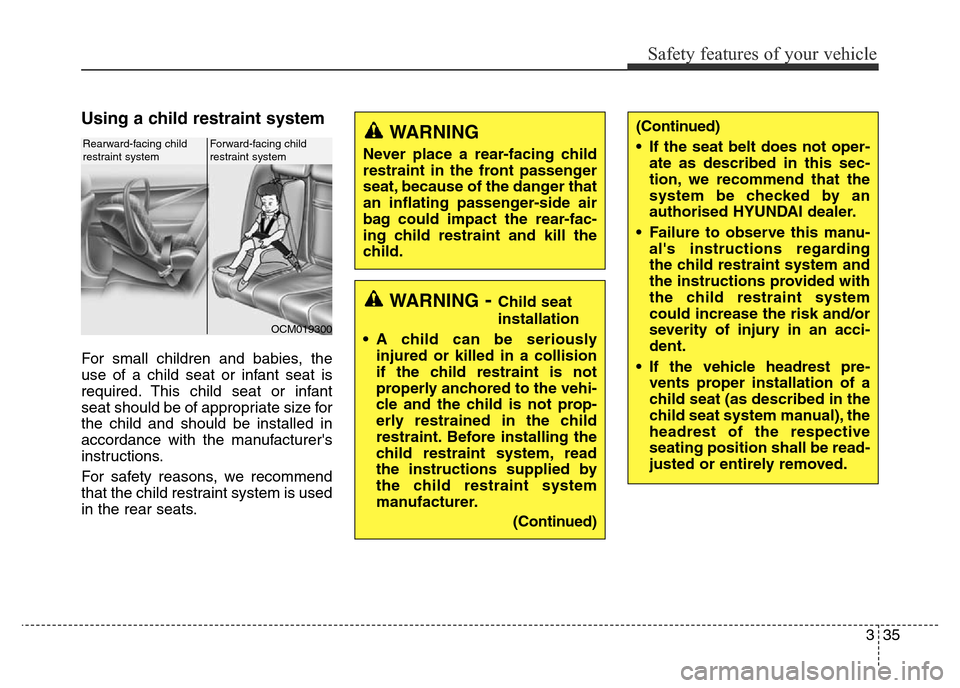
335
Safety features of your vehicle
Using a child restraint system
For small children and babies, the
use of a child seat or infant seat is
required. This child seat or infant
seat should be of appropriate size for
the child and should be installed in
accordance with the manufacturer's
instructions.
For safety reasons, we recommend
that the child restraint system is used
in the rear seats.
WARNING- Child seat
installation
• A child can be seriously
injured or killed in a collision
if the child restraint is not
properly anchored to the vehi-
cle and the child is not prop-
erly restrained in the child
restraint. Before installing the
child restraint system, read
the instructions supplied by
the child restraint system
manufacturer.
(Continued)
WARNING
Never place a rear-facing child
restraint in the front passenger
seat, because of the danger that
an inflating passenger-side air
bag could impact the rear-fac-
ing child restraint and kill the
child.
OCM019300
Rearward-facing child
restraint systemForward-facing child
restraint system
(Continued)
• If the seat belt does not oper-
ate as described in this sec-
tion, we recommend that the
system be checked by an
authorised HYUNDAI dealer.
• Failure to observe this manu-
al's instructions regarding
the child restraint system and
the instructions provided with
the child restraint system
could increase the risk and/or
severity of injury in an acci-
dent.
• If the vehicle headrest pre-
vents proper installation of a
child seat (as described in the
child seat system manual), the
headrest of the respective
seating position shall be read-
justed or entirely removed.
Page 54 of 498
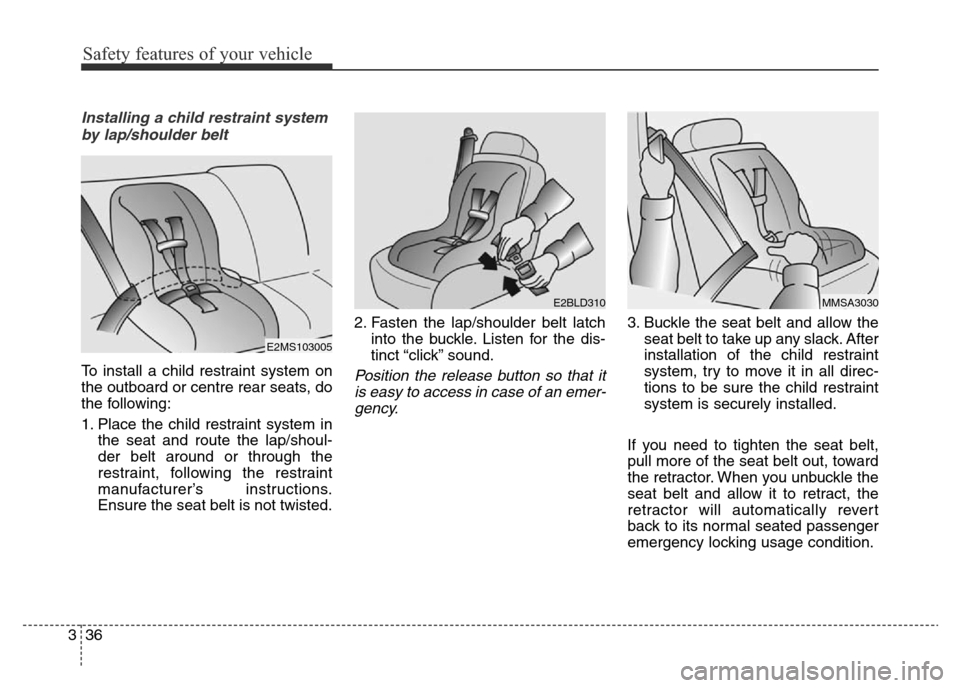
Safety features of your vehicle
36 3
Installing a child restraint system
by lap/shoulder belt
To install a child restraint system on
the outboard or centre rear seats, do
the following:
1. Place the child restraint system in
the seat and route the lap/shoul-
der belt around or through the
restraint, following the restraint
manufacturer’s instructions.
Ensure the seat belt is not twisted.2. Fasten the lap/shoulder belt latch
into the buckle. Listen for the dis-
tinct “click” sound.Position the release button so that it
is easy to access in case of an emer-
gency.
3. Buckle the seat belt and allow the
seat belt to take up any slack. After
installation of the child restraint
system, try to move it in all direc-
tions to be sure the child restraint
system is securely installed.
If you need to tighten the seat belt,
pull more of the seat belt out, toward
the retractor. When you unbuckle the
seat belt and allow it to retract, the
retractor will automatically revert
back to its normal seated passenger
emergency locking usage condition.
MMSA3030E2BLD310
E2MS103005
Page 55 of 498

337
Safety features of your vehicle
If the child seat moves, readjust the
length of the seat belt. In
Australia/NZ the child restraint man-
ufacturer's instructions must be fol-
lowed when fitting the unit to the
vehicle.Securing a child restraint seat
with “Tether Anchor” system
Child restraint hook holders are
located on the package tray.1.Route the child restraint seat strap
over the seatback.
For vehicles with adjustable head-
rest, route the tether strap under
the headrest and between the
headrest posts, otherwise route
the tether strap over the top of the
seatback.
2.Open the tether anchor cover.
3.Connect the tether strap hook to
the appropriate child restraint hook
holder and tighten to secure the
seat.
OMD030030N
OMD030021N
Page 56 of 498
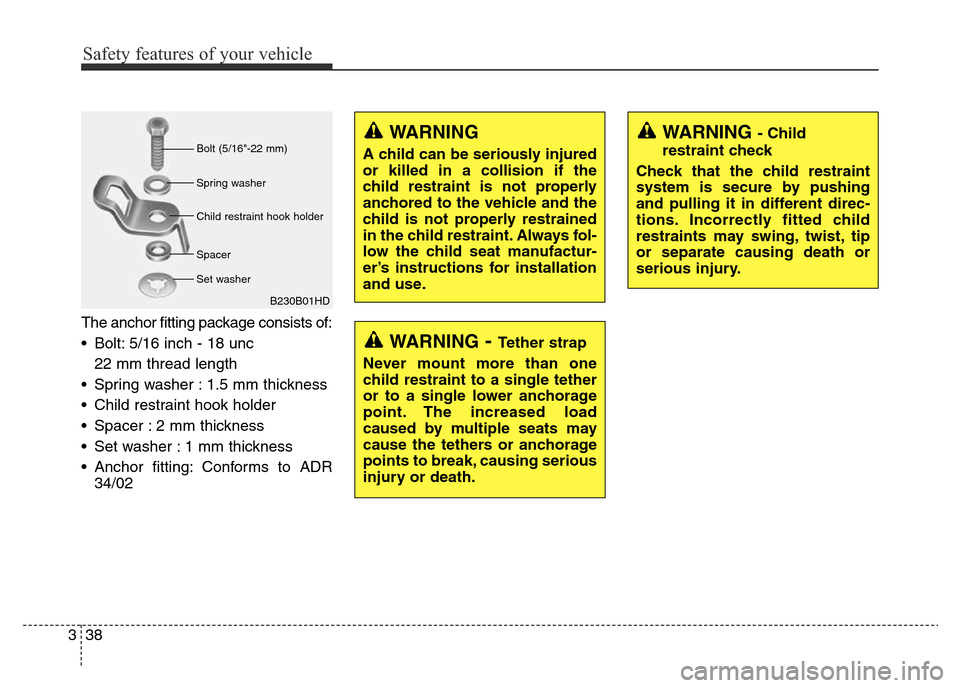
Safety features of your vehicle
38 3
The anchor fitting package consists of:
• Bolt: 5/16 inch - 18 unc
22 mm thread length
• Spring washer : 1.5 mm thickness
• Child restraint hook holder
• Spacer : 2 mm thickness
• Set washer : 1 mm thickness
• Anchor fitting: Conforms to ADR
34/02
WARNING- Tether strap
Never mount more than one
child restraint to a single tether
or to a single lower anchorage
point. The increased load
caused by multiple seats may
cause the tethers or anchorage
points to break, causing serious
injury or death.
WARNING
A child can be seriously injured
or killed in a collision if the
child restraint is not properly
anchored to the vehicle and the
child is not properly restrained
in the child restraint. Always fol-
low the child seat manufactur-
er’s instructions for installation
and use.
B230B01HD Bolt (5/16"-22 mm)
Spring washer
Child restraint hook holder
Set washer
Spacer
WARNING - Child
restraint check
Check that the child restraint
system is secure by pushing
and pulling it in different direc-
tions. Incorrectly fitted child
restraints may swing, twist, tip
or separate causing death or
serious injury.
Page 57 of 498
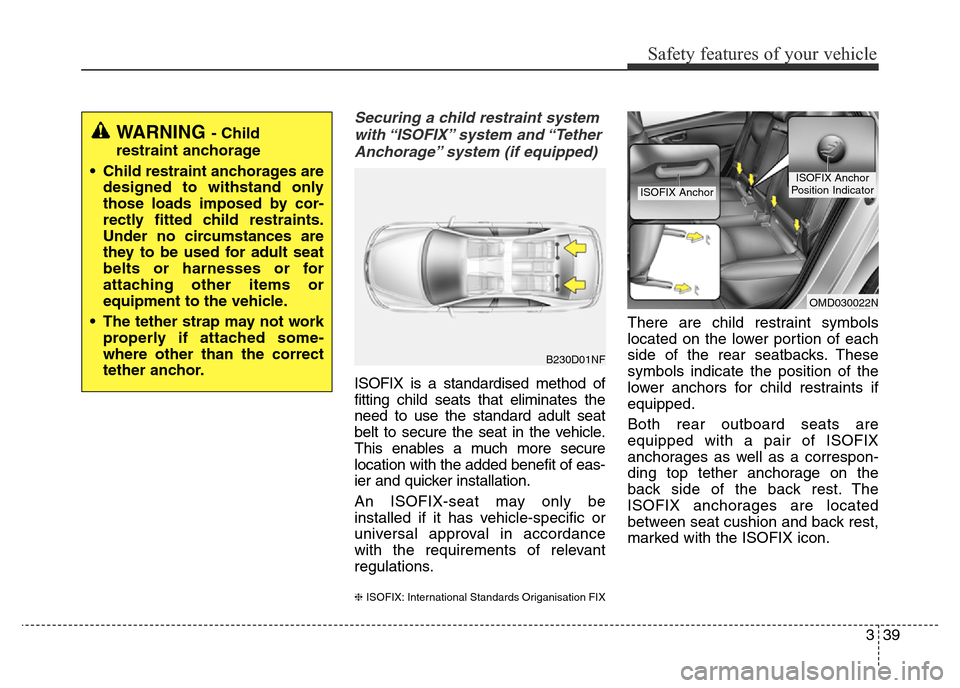
339
Safety features of your vehicle
Securing a child restraint system
with “ISOFIX” system and “Tether
Anchorage” system (if equipped)
ISOFIX is a standardised method of
fitting child seats that eliminates the
need to use the standard adult seat
belt to secure the seat in the vehicle.
This enables a much more secure
location with the added benefit of eas-
ier and quicker installation.
An ISOFIX-seat may only be
installed if it has vehicle-specific or
universal approval in accordance
with the requirements of relevant
regulations.
❈ISOFIX: International Standards Origanisation FIX
There are child restraint symbols
located on the lower portion of each
side of the rear seatbacks. These
symbols indicate the position of the
lower anchors for child restraints if
equipped.
Both rear outboard seats are
equipped with a pair of ISOFIX
anchorages as well as a correspon-
ding top tether anchorage on the
back side of the back rest. The
ISOFIX anchorages are located
between seat cushion and back rest,
marked with the ISOFIX icon.
B230D01NF
OMD030022N
ISOFIX AnchorISOFIX Anchor
Position Indicator
WARNING - Child
restraint anchorage
• Child restraint anchorages are
designed to withstand only
those loads imposed by cor-
rectly fitted child restraints.
Under no circumstances are
they to be used for adult seat
belts or harnesses or for
attaching other items or
equipment to the vehicle.
• The tether strap may not work
properly if attached some-
where other than the correct
tether anchor.